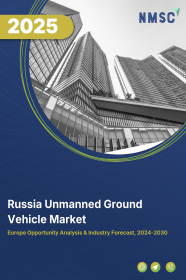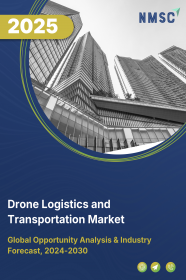
Russia Unmanned Ground Vehicle Market by Mode of Operation (Teleoperated and Autonomous), by Mode of Locomotion (Tracked, Wheeled, Legged, and Hybrid), by Size (Small, Medium, and Heavy), and by End-User Industry (Military & Defense, Agriculture, Mining, Law Enforcement, and Others) – Opportunity Analysis and Industry Forecast, 2024–2030
Industry: Aerospace & Defense | Publish Date: 07-Jan-2025 | No of Pages: 129 | No. of Tables: 96 | No. of Figures: 61 | Format: PDF | Report Code : AD2584
US Tariff Impact on Russia Unmanned Ground Vehicle Market
Trump Tariffs Are Reshaping Global Business
Russia Unmanned Ground Vehicle Market Overview:
The Russia Unmanned Ground Vehicle Market size was valued at USD 80.5 million in 2023, and is predicted to reach USD 113.5 million by 2030, with a CAGR of 5.0% from 2024 to 2030. In terms of volume, the market size was 624 units in 2023, and is projected to reach 1316 units by 2030, with a CAGR of 11.2% from 2024 to 2030.
Unmanned ground vehicles (UGVs) are robotic platforms designed to function independently on land without direct human control. They come in various sizes, from compact and agile to larger, rugged models capable of navigating rough terrain. While some UGVs are tailored for specific tasks such as pipeline inspection or handling hazardous materials, others offer versatility for different applications. Equipped with sensors, cameras, and specialized equipment, these vehicles are capable of performing a wide range of tasks. UGVs are employed in inspection, surveillance, mapping, and search and rescue operations. They are deployed in hazardous, repetitive, or contaminated environments, encompassing urban, rural, and off-road settings.
UGVs have applications across military, search and rescue, agricultural, and transportation sectors. UGVs can operate autonomously, making decisions and navigating independently, or they can be remotely controlled by a human operator. A key advantage of UGVs is their ability to undertake missions in environments that are dangerous or inaccessible to humans, such as bomb disposal, hazardous material inspection, or search and rescue operations in collapsed buildings. They are also utilized for tasks that are repetitive or monotonous for humans, including surveillance and patrolling. Additionally, they play a role in agriculture and forestry, including crop monitoring, mapping, and inspection of irrigation systems.
Increasing Adoption of UGVs in military and Defense Sector Drives the Russia UGV Market
The surge in funding for Russia's defense budget in 2023 has led to a heightened demand for unmanned ground vehicles (UGVs) for military purposes. With the announcement of a defense budget of approximately USD 84 billion for 2023, representing a significant increase from previous years, the Russian government emphasizes its commitment to strengthening its military capabilities. This increase in budget allocation extends to investments in military technology, including UGVs, which are increasingly crucial for modern warfare. The heightened investment in UGVs translates into expanded research and development, production, and deployment of these vehicles within the Russian military, consequently driving growth in the UGV market in Russia.
Increasing Investment in Military Robotics Boosts the Russia UGV Market
The Russian government's substantial investment in the development of AI technology, particularly for military applications, further propels the growth of the Russia UGV market in the country. With a planned allocation of USD 4.03 billion for AI development until 2024, aimed at creating advanced AI systems for military use, there is a clear indication of the growing demand for robotic systems in military operations. This strategic investment underscores the government's interest in integrating UGVs into its military strategies, thereby increasing the demand for these vehicles in the market. The objective of developing AI systems for military applications suggests a significant role for UGVs in future military operations, driving further market expansion.
High Cost and Lack of Standardization of UGVs Restrain the Russia Unmanned Ground Vehicle Market Growth
The significant expenses associated with developing and deploying Unmanned Ground Vehicles (UGVs) represent a major obstacle to the market's expansion. Typically, UGVs involve substantial investments in both their development and manufacturing phases, discouraging certain companies or organizations from investing in them. These vehicles necessitate advanced technologies and specialized components, resulting in significant costs for production and maintenance. Furthermore, the complex and time-consuming process of integrating UGVs into existing systems and workflows further inflates their overall cost. Moreover, the lack of standardization within the UGV market presents another challenge to its growth. Various UGV types and sizes are available, often tailored for specific tasks or environments, complicating the selection process for companies and the creation of products compatible with diverse systems and applications by manufacturers.
The Convergence of AI and the Advancement of Intelligent UGVs Generate Numerous Opportunities
The integration of artificial intelligence (AI) into Unmanned Ground Vehicles (UGVs) heralds new possibilities for the development of intelligent UGVs. Outfitted with advanced technologies such as machine learning and natural language processing, these vehicles possess the ability to execute tasks autonomously and make decisions at an advanced level, thereby enhancing their precision and reliability and positioning them as valuable assets across various industries.
The emergence of intelligent UGVs has the potential to revolutionize numerous sectors by augmenting efficiency, reducing reliance on human labor, and fortifying safety measures. Within the military and defense domain, intelligent UGVs are deployed for reconnaissance and surveillance purposes, delivering crucial intelligence while mitigating risks to human personnel. Similarly, in agriculture, they contribute to activities such as precision farming, amplifying crop yields and minimizing resource consumption. Consequently, the progression of intelligent UGVs represents a significant market opportunity, poised to profoundly influence various sectors and foster fresh avenues for growth and innovation.
Competitive Landscape
Several market players operating in the Russia unmanned ground vehicle industry include QinetiQ Group, Elbit System, Rheinmetall AG, General Dynamics Corporation, Teledyne FLIR LLC, L3Harris Technologies, Inc., Textron Systems (Howe & Howe Technologies), Boston Dynamics, Milrem Robotics, and Clearpath Robotics. These market players are adopting various strategies to maintain their dominance in the market.
Russia Unmanned Ground Vehicle Market Key Segments
By Mode of Operation
-
Teleoperated
-
Autonomous
By Mode of Locomotion
-
Tracked
-
Wheeled
-
Legged
-
Hybrid
By Size
-
Small
-
Medium
-
Heavy
By End-User Industry
-
Military and Defense
-
Agriculture
-
Mining
-
Law Enforcement
-
Others
REPORT SCOPE AND SEGMENTATION:
|
Parameters |
Details |
|
Market Size in 2023 |
USD 80.5 Million |
|
Revenue Forecast in 2030 |
USD 113.5 Million |
|
Value Growth Rate |
CAGR of 5.0% from 2024 to 2030 |
|
Market Volume in 2023 |
624 Units |
|
Unit Forecast in 2030 |
1316 Units |
|
Volume Growth Rate |
CAGR of 11.2% from 2024 to 2030 |
|
Analysis Period |
2023–2030 |
|
Base Year Considered |
2023 |
|
Forecast Period |
2024–2030 |
|
Market Size Estimation |
Million (USD) |
|
Growth Factors |
|
|
Companies Profiled |
10 |
|
Market Share |
Available for 10 companies |
|
Customization Scope |
Free customization (equivalent up to 80 working hours of analysts) after purchase. Addition or alteration to country, regional, and segment scope. |
|
Pricing and Purchase Options |
Avail customized purchase options to meet your exact research needs. |
KEY PLAYERS
-
QinetiQ Group
-
Elbit System
-
Rheinmetall AG
-
General Dynamics Corporation
-
Teledyne FLIR LLC
-
L3Harris Technologies, Inc.
-
Textron Systems (Howe & Howe Technologies)
-
Boston Dynamics
-
Milrem Robotics
-
Clearpath Robotics

















 Speak to Our Analyst
Speak to Our Analyst

















